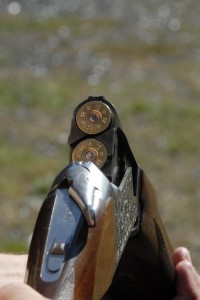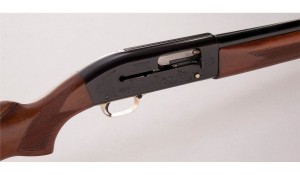Clay Pigeon Shooting Tutorial
May 13, 2014 by admin
Filed under Sports & Hobbies
Everything You Need to Know About Clay Pigeon Shooting
Three Shotguns Designs
Semi-Automatic, Over and Under and Side by Side are the 3 main 12 bore gun designs used by the majority of shooters.
Side by side shotguns are regularly used by traditional game shooters. Their barrels are next to each other.
Over and under shotguns have barrels on top of each other. Over and unders are usually used for clay pigeon shooting.
Single barreled semi-auto’s are often used by wild game shooters for pigeon shooting.
Adult shooters tend to prefer Twelve gauge shotguns because they are offer the best combination of performance for the weight.
Many juniors, ladies and other shooters looking for a lighter gun with less recoil, opt for a 20 bore shotgun which is smaller and uses smaller cartridges.
Clay Pigeon Shooting Equipment You Will Need
Shotgun Slip
A good gun sleeve will protect your shot gun from damage while you are carrying it.
Cartridge Bags
Different types of shooting require different shooting attire and cartridge bags. For some a pocket or pouch will be better than a bag.
Eye Protection
All good clay shooting grounds require eye protection to be worn while shooting. This is because of flying clay debris potentially injuring shooters.
Ear Protection
Using ear defenders will safeguard your hearing against the noise made when pulling the trigger. Professional shoots usually insist on hearing protection being used while shooting.
Cartridges for Shotguns
All shot gun shooters have their favourite cartridges that they like to shoot with, and there are many manufacturers to choose from. Most shots stick with a type that they have shot well with!
Different range targets often require different sizes of pellets for the best chance of hitting it consistently. Bigger leadshot goes further but there are less pellets of leadshot in each cartridge. Lighter pellets don’t fly as far but you have a wider ‘pattern’ to hit the clay with at shorter distances.
The ideal velocity of your cartridges will vary depending on how your hand/eye coordination perceives the target. Quicker cartridges require less ‘lead’ ahead of the clay, slower cartridges require more.
Two Disciplines: Skeet and Sporting
Olympic Skeet Shooting
Wherever you shoot skeet, the clays will fly on a similar path. This enables you to shoot the same targets at any skeet shooting ground worldwide.
Skeet shooting is a discipline of self control and self discipline. A skeet round is twenty five targets shot from the 7 stands in turn and it is unusual for shooters to achieve 100 without loss.
Sporting Clay Shooting
Sporting shooting is more akin game shooting in so far as every shooting club will have a large variety of targets on offer. There is always something new to try and the variety of clays on offer is endless.
Clay Target Differences
‘Standard’ clays are 110mm dia.
A Midi is a smaller standard shaped clay, 90mm in diameter
Mini – 60mm Diameter – often called bumble bees, these look minute and very fast!
A Battue is a flat target with a lipped outer edge, with a 55mm radius. Battues are mainly used for looping targets because they twist in the air as they decelerate, providing the shooter with a new challenge!
Rabbits ape real rabbits, so the clays have to be tougher so they don’t break too easily when they bounce across the ground.
Basic Clay Pigeon Shooting Principles
Shooting is a hand eye coordination discipline. In the same way as you catch a ball, you gauge your shot so it intersects with the clay as it flies through the air.
The two important skills you need to be a good shot are hand/eye coordination and the experience to understand what the target is doing so you can anticipate it’s correct flight path.
When your shot leaves your gun, it moves through the air in oval cloud. All you need to do is to make certain that the clay flies through that cigar of lead.
Your shot is travelling at speeds between 1350 and 1650 feet per second, and the clay is moving too.
Many targets look simple but are often doing more complex things in flight, misleading your eyes and making you miss.
Basic Shooting Techniques
The two basic techniques are ‘maintain lead’ and ‘swing through’. Using either of these methods, the 2 factors that will hit the target are speed of gun movement & the exact point that you pull the trigger.
Maintain lead is the most popular technique to start off with. Maintain lead involves swinging your barrels through the clays path of flight, keeping your barrels the distance in front of the target that you feel is the right amount of lead.
Experienced shots often use swing through as their technique. Swing through involves coming from behind, & swinging your barrels through the clay, shooting when your natural instinct tells you that you have applied the correct amount of lead.
Basic Targets
Clay targets come in seven different styles which replicate different game birds.
Rabbits
Rabbits bounce quickly along the ground, copying a real real rabbit. The clays are stronger that standard clays although they are the same diameter.
Teal
Teal can be difficult to hit. They fly straight upwards very quickly, requiring a seat of the pants, swing through technique that many find difficult. In many instances they can also be hit as they drop as well as rising.
Quartering
By looking at where the trap house is and where it lands you can see how much the target is quartering towards or away from you. Quartering clays usually require less lead than a crossing target, so knowing its true flight path is critical.
Driven Clays
Driven targets replicate birds being driven over the guns. Your barrels will hide the bird just as you need to shoot, so you have to use a swing through technique to hit them consistently.
Incoming Birds
Incomers head towards you, but unlike driven birds, they drop before reaching you rather then flying over your head.
Going Away Clays
Targets going away from you need lots of confidence and speed so you can hit them before they become too small to break.
Loopers
Looping targets start off rising, before falling, and often quarter towards or away from you. Hitting a looper can be tricky and requires patience and practice. Some shooters prefer to hit them rising, while others wait for them to begin to drop before pulling the trigger.



